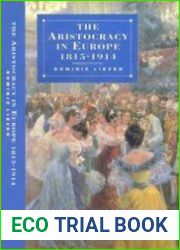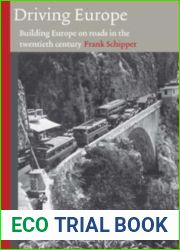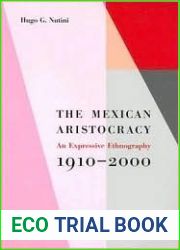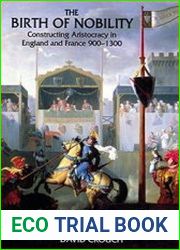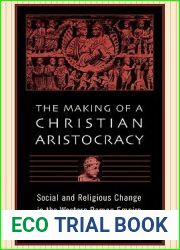
BOOKS - HISTORY - The Aristocracy in Europe 1815-1914

The Aristocracy in Europe 1815-1914
Author: Dominic Lieven
Year: 1993
Pages: 308
Format: PDF
File size: 220.87 MB
Language: ENG

Year: 1993
Pages: 308
Format: PDF
File size: 220.87 MB
Language: ENG

The Aristocracy in Europe, 1815-1914 In his book "The Aristocracy in Europe, 1815-1914 Dominic Lieven delves into the challenges faced by the hereditary elites in the 19th century and how they responded to these challenges in different ways. The book focuses on the three most powerful monarchies in Europe - Germany, England, and Russia - and examines the wealth, economic activities, manners, and morals of the ennobled upper class during this period. Lieven argues that the aristocracy viewed the Industrial Revolution and the expansion of the franchise in Britain as a threat to their power and right to rule, and explores their strategies for addressing this danger. The book begins with a description of the aristocratic lifestyle in the early 19th century, highlighting the luxurious living conditions and the emphasis on etiquette and social status. However, as the century progressed, the industrial revolution began to transform the economy and society, leading to increased educational and occupational opportunities for the middle classes. This shift posed a significant threat to the power and influence of the aristocracy, who saw their privileged position being eroded. In response, the aristocracy in each country developed unique strategies to maintain their status and power. In Germany, the aristocracy sought to preserve their cultural and social dominance by promoting nationalism and militarism, while in England, they focused on preserving their economic interests through the development of new industries and technologies.
Аристократия в Европе, 1815-1914 В своей книге «Аристократия в Европе, 1815-1914» Доминик Ливен углубляется в проблемы, с которыми столкнулись наследственные элиты в XIX веке, и в то, как они по-разному реагировали на эти проблемы. Книга посвящена трем самым могущественным монархиям в Европе - Германии, Англии и России - и рассматривает богатство, экономическую деятельность, манеры и нравы облагороженного высшего класса в этот период. Ливен утверждает, что аристократия рассматривала Промышленную революцию и расширение франшизы в Британии как угрозу их власти и праву на правление, и исследует их стратегии для устранения этой опасности. Книга начинается с описания аристократического образа жизни начала XIX века, подчёркивая роскошные условия жизни и акцент на этикете и социальном статусе. Однако по мере развития века промышленная революция начала трансформировать экономику и общество, что привело к увеличению образовательных и профессиональных возможностей для среднего класса. Этот сдвиг представлял значительную угрозу власти и влиянию аристократии, которая видела, как их привилегированное положение размывается. В ответ аристократия в каждой стране разрабатывала уникальные стратегии для поддержания своего статуса и власти. В Германии аристократия стремилась сохранить своё культурное и социальное доминирование, пропагандируя национализм и милитаризм, в то время как в Англии они сосредоточились на сохранении своих экономических интересов посредством развития новых отраслей и технологий.
L'aristocratie en Europe, 1815-1914 Dans son livre « L'aristocratie en Europe, 1815-1914 », Dominique Liven s'intéresse aux problèmes rencontrés par les élites héréditaires au XIXe siècle et à la façon dont elles ont réagi différemment à ces problèmes. livre traite des trois monarchies les plus puissantes d'Europe - l'Allemagne, l'Angleterre et la Russie - et examine la richesse, l'activité économique, le savoir-vivre et les moeurs de la classe supérieure taxée pendant cette période. Lieven affirme que l'aristocratie considérait la révolution industrielle et l'expansion de la franchise en Grande-Bretagne comme une menace pour leur pouvoir et leur droit de gouverner, et étudie leurs stratégies pour faire face à ce danger. livre commence par une description du mode de vie aristocratique du début du XIXe siècle, soulignant les conditions de vie luxueuses et l'accent mis sur le savoir-vivre et le statut social. Cependant, au fil du siècle, la révolution industrielle a commencé à transformer l'économie et la société, ce qui a accru les possibilités d'éducation et de formation pour la classe moyenne. Ce changement représentait une menace considérable pour le pouvoir et l'influence de l'aristocratie, qui voyait leur position privilégiée s'éroder. En réponse, l'aristocratie de chaque pays a élaboré des stratégies uniques pour maintenir son statut et son pouvoir. En Allemagne, l'aristocratie s'est efforcée de préserver sa domination culturelle et sociale en promouvant le nationalisme et le militarisme, tandis qu'en Angleterre, elle s'est attachée à préserver ses intérêts économiques en développant de nouvelles industries et technologies.
Aristocracia en , 1815-1914 En su libro «La aristocracia en , 1815-1914», Dominique aven profundiza en los problemas a los que se enfrentaron las élites hereditarias en el siglo XIX y en la manera en que respondieron de diferentes maneras a estos problemas. libro trata sobre las tres monarquías más poderosas de - Alemania, Inglaterra y Rusia - y examina la riqueza, la actividad económica, los modales y la moral de la clase alta ennoblecida durante este período. aven sostiene que la aristocracia vio la Revolución Industrial y la expansión de la franquicia en Gran Bretaña como una amenaza a su poder y derecho a gobernar, y explora sus estrategias para eliminar este peligro. libro comienza describiendo el estilo de vida aristocrático de principios del siglo XIX, destacando las lujosas condiciones de vida y el énfasis en la etiqueta y el estatus social. n embargo, a medida que avanzaba el siglo, la revolución industrial comenzó a transformar la economía y la sociedad, lo que llevó a un aumento de las oportunidades educativas y profesionales para la clase media. Este cambio representaba una amenaza significativa para el poder y la influencia de la aristocracia, que veía erosionarse su posición privilegiada. En respuesta, la aristocracia en cada país desarrolló estrategias únicas para mantener su estatus y poder. En Alemania, la aristocracia buscaba mantener su dominio cultural y social promoviendo el nacionalismo y el militarismo, mientras que en Inglaterra se centraban en preservar sus intereses económicos a través del desarrollo de nuevas industrias y tecnologías.
Aristocracia na , 1815-1914 Em seu livro «Aristocracia na , 1815-1914», Dominique Liven aprofundou-se nos problemas enfrentados pelas elites hereditárias no século XIX. E na forma como eles responderam de forma diferente a estes problemas. O livro trata das três monarquias mais poderosas da - Alemanha, Inglaterra e Rússia - e aborda a riqueza, a atividade econômica, os modos e os costumes da classe alta tributada durante este período. Liven afirma que a aristocracia considerou a Revolução Industrial e a expansão da franquia na Grã-Bretanha como uma ameaça ao seu poder e ao seu direito de governar, e explora suas estratégias para lidar com esse perigo. O livro começa descrevendo o estilo de vida aristocrático do início do século XIX, enfatizando as condições de vida luxuosas e o foco na etiqueta e status social. No entanto, ao longo do século, a revolução industrial começou a transformar a economia e a sociedade, aumentando as oportunidades educacionais e profissionais para a classe média. Esta mudança representou uma ameaça significativa ao poder e ao impacto da aristocracia, que viu a sua posição privilegiada desmoronar-se. Como resposta, a aristocracia em cada país desenvolveu estratégias únicas para manter o seu status e poder. Na Alemanha, a aristocracia procurou manter seu domínio cultural e social, promovendo o nacionalismo e o militarismo, enquanto na Inglaterra eles se concentraram em preservar seus interesses econômicos através do desenvolvimento de novas indústrias e tecnologias.
Aristocrazia in , 1815-1914 Nel suo libro «Aristocrazia in , 1815-1914», Dominik Liven approfondisce i problemi affrontati dalle élite ereditarie nel XIX secolo e il modo in cui hanno reagito in modo diverso a questi problemi. Il libro parla delle tre monarchie più potenti d'- Germania, Inghilterra e Russia - e affronta la ricchezza, l'attività economica, le modalità e le menti di una classe superiore sovrastante in questo periodo. Liven sostiene che l'aristocrazia abbia considerato la rivoluzione industriale e l'espansione della franchigia in Gran Bretagna come una minaccia per il loro potere e il diritto di governare, e sta esplorando le loro strategie per affrontare questo pericolo. Il libro inizia descrivendo lo stile di vita aristocratico dell'inizio del XIX secolo, sottolineando le condizioni di vita lussuose e l'accento sull'etichetta e lo status sociale. Tuttavia, nel corso del secolo, la rivoluzione industriale ha iniziato a trasformare l'economia e la società, aumentando le opportunità educative e professionali per la classe media. Questo cambiamento ha rappresentato una minaccia significativa al potere e all'influenza dell'aristocrazia, che ha visto la loro posizione privilegiata sfumare. In risposta, l'aristocrazia in ogni paese ha sviluppato strategie uniche per mantenere il proprio status e potere. In Germania, l'aristocrazia ha cercato di preservare il suo dominio culturale e sociale promuovendo il nazionalismo e il militarismo, mentre in Inghilterra si sono concentrati sulla salvaguardia dei loro interessi economici attraverso lo sviluppo di nuove industrie e tecnologie.
Aristokratie in , 1815-1914 In seinem Buch „Aristokratie in , 1815-1914“ beschäftigt sich Dominique Lieven mit den Problemen, mit denen erbliche Eliten im 19. Jahrhundert konfrontiert waren und wie sie unterschiedlich auf diese Probleme reagierten. Das Buch konzentriert sich auf die drei mächtigsten Monarchien in - Deutschland, England und Russland - und untersucht den Reichtum, die wirtschaftlichen Aktivitäten, die Manieren und die tten der geadelten Oberschicht in dieser Zeit. Lieven argumentiert, dass die Aristokratie die industrielle Revolution und die Expansion des Franchise in Großbritannien als Bedrohung für ihre Macht und ihr Recht auf Herrschaft betrachtete, und untersucht ihre Strategien, um dieser Gefahr zu begegnen. Das Buch beginnt mit einer Beschreibung des aristokratischen bensstils zu Beginn des 19. Jahrhunderts und betont die luxuriösen bensbedingungen und die Betonung von Etikette und sozialem Status. Im Laufe des Jahrhunderts begann die industrielle Revolution jedoch, Wirtschaft und Gesellschaft zu verändern, was zu einer Zunahme der Bildungs- und Berufschancen für die Mittelschicht führte. Diese Verschiebung stellte eine erhebliche Bedrohung für die Macht und den Einfluss der Aristokratie dar, die ihre privilegierte Position erodieren sah. Als Reaktion darauf entwickelte die Aristokratie in jedem Land einzigartige Strategien, um ihren Status und ihre Macht zu erhalten. In Deutschland versuchte die Aristokratie, ihre kulturelle und soziale Dominanz durch die Förderung von Nationalismus und Militarismus zu erhalten, während sie sich in England auf die Wahrung ihrer wirtschaftlichen Interessen durch die Entwicklung neuer Industrien und Technologien konzentrierte.
Arystokracja w Europie, 1815-1914 W książce „Arystokracja w Europie, 1815-1914”, Dominic Lieven zagłębia się w problemy, z jakimi borykają się dziedziczne elity w XIX wieku i jak inaczej zareagowali na te problemy. Książka skupia się na trzech najpotężniejszych monarchiach w Europie - Niemczech, Anglii i Rosji - i patrzy na bogactwo, działalność gospodarczą, maniery i obyczaje uszlachetnionej wyższej klasy w tym okresie. Lieven twierdzi, że arystokracja widziała Rewolucję Przemysłową i ekspansję franczyzową w Wielkiej Brytanii jako zagrożenie dla ich władzy i prawa do rządzenia, i bada swoje strategie rozwiązania tego niebezpieczeństwa. Książka zaczyna się od opisu arystokratycznego stylu życia z początku XIX wieku, podkreślając luksusowe warunki życia i nacisk na etykiety i status społeczny. Jednak wraz z postępem wieku, rewolucja przemysłowa zaczęła przekształcać gospodarkę i społeczeństwo, prowadząc do zwiększenia możliwości edukacyjnych i zawodowych dla klasy średniej. Przesunięcie to stanowiło znaczące zagrożenie dla władzy i wpływów arystokracji, która widziała ich uprzywilejowaną pozycję osłabioną. W odpowiedzi arystokracja w każdym kraju opracowała unikalne strategie utrzymania swojego statusu i władzy. W Niemczech arystokracja dążyła do utrzymania dominacji kulturowej i społecznej poprzez promowanie nacjonalizmu i militaryzmu, natomiast w Anglii skupiła się na zachowaniu swoich interesów gospodarczych poprzez rozwój nowych gałęzi przemysłu i technologii.
אריסטוקרטיה באירופה, 1815-1914 בספרו ”אריסטוקרטיה באירופה, 1815-1914”, דומיניק ליבן מתעמק בבעיות שעומדות בפני האליטות התורשתיות במאה ה-19 וכיצד הן הגיבו באופן שונה לבעיות אלה. הספר מתמקד בשלוש המונרכיות החזקות ביותר באירופה - גרמניה, אנגליה ורוסיה - ומסתכל על העושר, הפעילויות הכלכליות, הנימוסים והמורלות של המעמד העליון בתקופה זו. ליבן טוען שהאריסטוקרטיה ראתה במהפכה התעשייתית ובהרחבת הזיכיון בבריטניה איום על כוחם וזכותם לשלוט, ובוחנת את האסטרטגיות שלהם לטיפול בסכנה זו. הספר מתחיל בתיאור סגנון החיים האריסטוקרטי של תחילת המאה ה-19, תוך שימת דגש על תנאי מחיה מפוארים ודגש על כללי התנהגות ומעמד חברתי. עם זאת, ככל שהמאה התקדמה, המהפכה התעשייתית החלה לשנות את הכלכלה והחברה, מה שהוביל להגברת ההזדמנויות החינוכיות והמקצועיות של המעמד הבינוני. שינוי זה היווה איום משמעותי על כוחה והשפעתה של האצולה, אשר ראתה את מעמדם המיוחס נשחק. בתגובה פיתחו האצולה בכל מדינה אסטרטגיות ייחודיות לשמירת מעמדם וכוחם. בגרמניה, האצולה ביקשה לשמור על הדומיננטיות התרבותית והחברתית שלה על ידי קידום לאומיות ומיליטריזם, בעוד שבאנגליה הם התמקדו בשימור האינטרסים הכלכליים שלהם באמצעות פיתוח תעשיות וטכנולוגיות חדשות.''
Avrupa'da Aristokrasi, 1815-1914 Dominic Lieven, "Avrupa'da Aristokrasi, 1815-1914'adlı kitabında, kalıtsal seçkinlerin 19. yüzyılda karşılaştıkları sorunları ve bu sorunlara nasıl farklı tepkiler verdiklerini ele alıyor. Kitap, Avrupa'daki en güçlü üç monarşiye (Almanya, İngiltere ve Rusya) odaklanıyor ve bu dönemde yüceltilen üst sınıfın zenginliğine, ekonomik faaliyetlerine, görgü ve adetlerine bakıyor. Lieven, aristokrasinin Sanayi Devrimi'ni ve Britanya'daki franchise genişlemesini iktidarlarına ve yönetme haklarına bir tehdit olarak gördüğünü ve bu tehlikeyi ele alma stratejilerini araştırdığını savunuyor. Kitap, 19. yüzyılın başlarındaki aristokrat yaşam tarzının lüks yaşam koşullarını vurgulayan ve görgü kuralları ve sosyal statüye vurgu yapan bir açıklamayla başlıyor. Bununla birlikte, yüzyıl ilerledikçe, Sanayi Devrimi ekonomiyi ve toplumu dönüştürmeye başladı ve orta sınıf için artan eğitim ve mesleki fırsatlara yol açtı. Bu değişim, ayrıcalıklı konumlarının aşındığını gören aristokrasinin gücü ve etkisi için önemli bir tehdit oluşturdu. Buna karşılık, her ülkedeki aristokrasi, statülerini ve güçlerini korumak için benzersiz stratejiler geliştirdi. Almanya'da aristokrasi, milliyetçiliği ve militarizmi teşvik ederek kültürel ve sosyal egemenliklerini korumaya çalışırken, İngiltere'de yeni sanayi ve teknolojilerin geliştirilmesi yoluyla ekonomik çıkarlarını korumaya odaklandılar.
الأرستقراطية في أوروبا، 1815-1914 في كتابه «الأرستقراطية في أوروبا، 1815-1914»، يتعمق دومينيك ليفن في المشاكل التي واجهتها النخب الوراثية في القرن التاسع عشر وكيف تفاعلت بشكل مختلف مع هذه المشاكل. يركز الكتاب على أقوى ثلاث أنظمة ملكية في أوروبا - ألمانيا وإنجلترا وروسيا - ويلقي نظرة على الثروة والأنشطة الاقتصادية والأخلاق والأعراف للطبقة العليا المرموقة خلال هذه الفترة. يجادل ليفن بأن الطبقة الأرستقراطية رأت في الثورة الصناعية وتوسع الامتياز في بريطانيا تهديدًا لقوتهم وحقهم في الحكم، وتستكشف استراتيجياتهم لمعالجة هذا الخطر. يبدأ الكتاب بوصف أسلوب الحياة الأرستقراطي في أوائل القرن التاسع عشر، مع التركيز على الظروف المعيشية الفاخرة والتركيز على آداب السلوك والمكانة الاجتماعية. ومع ذلك، مع تقدم القرن، بدأت الثورة الصناعية في تغيير الاقتصاد والمجتمع، مما أدى إلى زيادة الفرص التعليمية والمهنية للطبقة الوسطى. شكل هذا التحول تهديدًا كبيرًا لسلطة ونفوذ الطبقة الأرستقراطية، التي شهدت تآكل موقفها المتميز. رداً على ذلك، وضعت الطبقة الأرستقراطية في كل بلد استراتيجيات فريدة للحفاظ على مركزها وسلطتها. في ألمانيا، سعت الطبقة الأرستقراطية إلى الحفاظ على هيمنتها الثقافية والاجتماعية من خلال تعزيز القومية والعسكرية، بينما ركزوا في إنجلترا على الحفاظ على مصالحهم الاقتصادية من خلال تطوير صناعات وتكنولوجيات جديدة.
유럽의 귀족, 1815-1914 그의 저서 "유럽의 귀족, 1815-1914" 에서 Dominic Lieven은 19 세기 유전 엘리트들이 직면 한 문제와 이러한 문제들에 어떻게 다르게 반응했는지 탐구합니다. 이 책은 독일, 영국, 러시아와 같은 유럽에서 가장 강력한 세 군주국에 중점을두고 있으며이 기간 동안 고귀한 상류층의 부, 경제 활동, 매너 및 관습을 살펴 봅니다. Lieven은 귀족이 영국의 산업 혁명과 프랜차이즈 확장을 그들의 권력과 통치권에 대한 위협으로보고이 위험을 해결하기위한 전략을 탐구한다고 주장했다. 이 책은 19 세기 초의 귀족 생활 양식에 대한 설명으로 시작하여 고급스러운 생활 조건과 에티켓과 사회적 지위에 중점을 둡니다. 그러나 세기가 진행됨에 따라 산업 혁명은 경제와 사회를 변화시키기 시작하여 중산층의 교육 및 전문 기회가 증가했습니다. 이러한 변화는 귀족의 힘과 영향력에 중대한 위협을 가했으며, 이로 인해 특권이 침식되었습니다. 이에 따라 각 국가의 귀족은 지위와 권력을 유지하기위한 독특한 전략을 개발했습니다. 독일에서는 귀족이 민족주의와 군사주의를 장려함으로써 문화적, 사회적 지배력을 유지하려고 노력했으며 영국에서는 새로운 산업과 기술의 발전을 통해 경제적 이익을 보존하는 데 중점을 두었습니다.
ヨーロッパの貴族、1815-1914彼の著書「ヨーロッパの貴族、1815-1914」では、ドミニク・リーヴンは19世紀に遺伝的エリートが直面した問題と、それらがこれらの問題にどのように異なる反応をしたかを掘り下げます。この本は、ヨーロッパで最も強力な3つの君主制(ドイツ、イギリス、ロシア)に焦点を当てており、この時期の上流階級の富、経済活動、マナー、モールを見ています。リーヴンは、貴族はイギリスにおける産業革命とフランチャイズ拡大を彼らの権力と支配権に対する脅威と見なし、この危険に対処するための戦略を模索していると主張している。本書は、19世紀初頭の貴族的生活様式の記述から始まり、豪華な生活環境とエチケットと社会的地位に重点を置いている。しかし、世紀が進むにつれて、産業革命は経済と社会を変革し始め、中産階級の教育と職業の機会を増やすことになった。この変化は貴族の権力と影響力に大きな脅威をもたらし、その特権的地位は崩壊した。それに応じて、各国の貴族は、その地位と権力を維持するための独自の戦略を開発しました。ドイツでは、貴族はナショナリズムと軍国主義を促進することで文化的、社会的優位性を維持しようとしたが、イギリスでは新しい産業や技術の発展を通じて経済的利益を維持することに焦点を当てた。
歐洲貴族,1815至1914多米尼克·利文(Dominic aven)在其著作《歐洲貴族,1815至1914》中深入探討了19世紀世襲精英所面臨的問題,以及他們如何以不同的方式應對這些問題。這本書涉及歐洲最強大的三個君主制-德國,英國和俄羅斯-並回顧了這一時期貴族上層階級的財富,經濟活動,舉止和道德。利文認為,貴族將英國工業革命和特許經營權的擴大視為對其權力和統治權的威脅,並研究了他們消除這種危險的策略。這本書首先描述了19世紀初期的貴族生活方式,強調了奢侈的生活條件以及對禮節和社會地位的強調。然而,隨著世紀的發展,工業革命開始改變經濟和社會狀況,從而為中產階級增加了教育和職業機會。這種轉變對權力和貴族的影響構成了重大威脅,使他們的特權地位受到侵蝕。作為回應,每個國家的貴族都制定了獨特的策略來維持其地位和權力。在德國,貴族試圖通過提倡民族主義和軍國主義來保持其文化和社會主導地位,而在英國,他們則致力於通過發展新產業和技術來維護其經濟利益。







